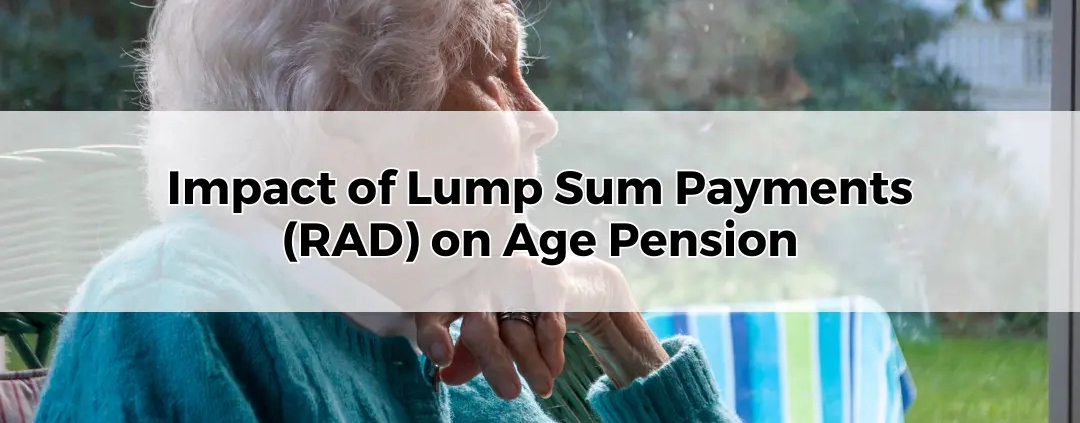Impact of Lump Sum Payments (RAD) on Age Pension
Table of Contents
ToggleNavigating the financial terrain of aged care can be complex, particularly when it comes to balancing accommodation costs with the Age Pension. For those entering residential aged care, one common payment method is the Refundable Accommodation Deposit (RAD). This lump sum payment secures a place in a residential facility, but its implications stretch beyond simply covering care fees. For pensioners, understanding how RAD affects Age Pension entitlements is critical. This deposit can impact how much pension one receives, with effects varying based on individual circumstances. Clarifying the role of RAD and its interaction with Age Pension entitlements can empower families and retirees to make informed decisions that serve their long-term financial security.
Refundable Accommodation Deposit (RAD)
The Refundable Accommodation Deposit (RAD) is an up-front payment that guarantees accommodation in a residential aged care facility. Essentially, RAD serves as a bond, paid directly to the aged care facility. Unlike a typical service fee, the RAD is largely refundable when the resident leaves the facility or upon passing, minus any agreed deductions for care or services. This payment offers flexibility; residents may opt to pay it entirely, partially, or choose alternative methods, such as a combination of daily and lump sum payments. The flexibility of RAD payments allows families to choose an option that aligns with their financial needs and Age Pension considerations. Given its substantial amount, understanding how this deposit affects pension eligibility and payments is crucial to managing aged care finances effectively.
Age Pension and Means Testing Explained
The Age Pension in Australia provides financial assistance to eligible seniors, with eligibility and payment amounts determined by a combination of income and asset tests, known collectively as means testing. This means test assesses assets and income, placing limits on pension amounts based on an individual’s or couple’s financial standing. Assets like savings, property, and investments are scrutinised, while income streams, including certain annuities and earnings, are also considered. For those entering aged care, the introduction of large deposits like the RAD may change the balance of assets or income in the assessment. The Age Pension means test is a complex system designed to tailor support based on financial need, so understanding the nuances of how a RAD payment fits within it can inform wise decision-making.
How RAD Payments Affect Means Testing for Age Pension
RAD payments are distinct in their treatment under means testing. Generally, the RAD is classified as an exempt asset, meaning it isn’t included directly in the asset test for Age Pension eligibility. However, the means test still considers the overall financial picture, so moving funds into a RAD payment may indirectly influence Age Pension calculations. While RAD payments can lower assessable assets and improve pension eligibility, the details can vary based on payment type and individual circumstances. Exploring the means-testing outcomes for different RAD payment structures is advisable for those aiming to maximise their Age Pension benefits while securing aged care accommodation.
Assessable Assets and Age Pension Eligibility
When evaluating Age Pension eligibility, one of the primary components examined is assessable assets, which generally include real estate (excluding the primary home), superannuation, investments, and savings. Although RAD payments are not counted as assessable assets, liquidating significant assets to fund a RAD payment can affect one’s pension eligibility. For example, if an individual sells investment properties or liquidates shares to fund the RAD, their total assessable asset value decreases, which may improve their pension entitlement. Understanding how RAD payments alter the asset landscape can help in planning a funding approach that preserves pension eligibility and optimises financial resources in aged care.
RAD as an Exempt Asset in Means Testing
The Australian government exempts RAD payments from the asset test component of means testing for Age Pension eligibility. This exemption provides a strategic opportunity for retirees to adjust their asset portfolio without impacting their pension qualification. However, this asset exemption does not eliminate all considerations, as moving capital into a RAD payment might reduce liquidity. For many, this trade-off becomes central to their financial planning strategy. By leveraging the asset exemption status of RAD, families may improve pension outcomes while fulfilling aged care obligations, thus achieving a balanced approach to both accommodation and pension income.
Income Test Implications of RAD Payments
While RADs are treated as exempt assets, they still influence the income test indirectly. Depending on how the RAD is financed, changes in financial arrangements may alter the reported income. For instance, withdrawing funds from an interest-bearing account to pay the RAD can reduce the income derived from those accounts, potentially leading to an increase in pension entitlements. However, if other assets are liquidated, any income generated by those assets (if reinvested) could offset income changes. The income test’s detailed parameters mean that every financial decision impacts pension amounts, making a tailored strategy essential for optimising income.
Comparing RAD and DAP for Age Pension Optimisation
Another option for aged care accommodation payments is the Daily Accommodation Payment (DAP), which is essentially a daily interest charge on the accommodation amount. Unlike RAD, DAP payments are not refundable but are treated differently under means testing. Some opt for a combination of RAD and DAP to retain flexibility while managing the pension impact. Each payment type has distinct advantages, depending on individual needs and financial resources. For those focused on preserving Age Pension entitlements, a strategic mix of RAD and DAP payments may provide an optimal solution that balances income, assets, and care costs.
Influence of RAD on Age Pension Reduction or Loss
Under certain conditions, a RAD payment could lead to a reduction or loss of Age Pension entitlements. Large RAD payments may reduce assessable assets significantly, which generally benefits pension outcomes. However, significant transfers of financial resources may also cause cash flow adjustments that influence pension payments in unexpected ways. Those planning substantial RAD payments should be prepared for a potential adjustment period during which Age Pension benefits may fluctuate. Understanding these possibilities helps retirees and families prepare for temporary reductions and strategically plan for the long term.
Impact on Family Members and Estate Planning Considerations
RAD payments, as refundable deposits, have implications for family members and inheritance planning. When the resident passes away, the RAD is refunded to the estate, less any outstanding fees. This characteristic makes RAD an important asset in estate planning, as it can be earmarked for family beneficiaries. Families must consider RAD within the broader scope of financial inheritance and succession. Balancing RAD payments with the Age Pension and other assets often requires a comprehensive approach that prioritises both aged care costs and the potential for generational wealth transfer.
Financial Strategies for Managing RAD and Age Pension Impact
Creating a financial plan that accommodates both RAD and Age Pension eligibility is essential for aged care planning. One approach is structuring payments to balance liquidity with maximised pension eligibility, possibly using a combination of part-RAD and part-DAP payments. Other strategies include retaining certain income-producing assets while minimising those assessed for means testing. Each strategy will differ based on the individual’s financial position and care needs. Consulting an experienced aged care financial adviser can help align these strategies with long-term care requirements and pension goals.
Conclusion
The decision to pay a RAD as part of residential aged care carries significant implications for Age Pension eligibility and broader financial planning. Understanding RAD’s unique treatment in means testing, and its impact on both assets and income, can lead to more informed decisions that balance care needs with financial preservation. For retirees and families, navigating these considerations with a trusted adviser ensures the decision supports both immediate needs and future goals. Taking the time to explore RAD’s influence on Age Pension eligibility can reveal strategies that empower families to make secure and financially sound decisions in aged care.









